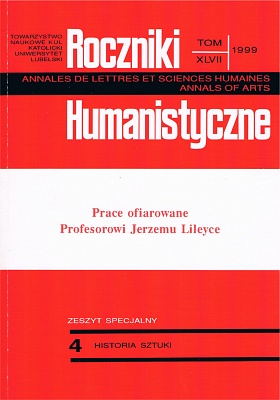The Samogitian Canon, Józef L. Łopaciński's Expensa on Paintings and Engravings During his Travel to Rome in the Years 1773-1775
Abstract
In the epoch of Enlightenment travel to Italy was considered good form; it constituted a necessary element of education for young people from aristocratic homes and fired the imagination of people studying the past and of artists. Representatives of various nations crowded to Italy at that time: Englishmen, Germans, Danes, Swedes, Russians and Poles. They were attracted by the perspective of idyllic adventure, the Arcadian landscapes, and a rich cultural offer. Foreign tourists were first of all fascinated by Rome, which was generally treated as the main destination in the then fashionable Grand Tour. Such a voyage ennobled the traveller giving him the glamour of a man of the world; and it was not seldom that in his memories it acquired the significance of the most important adventure in his life.
The list of Polish travellers is quite long and it includes the names of the most outstanding representatives of social élites of the epoch: it is enough to mention the names of August Moszyński, Izabela Lubomirska, Stanisław Kostka and Ignacy Potockis, Michał Borch, or the king's nephew, Stanisław Poniatowski. At the present stage of research the list is complemented with the name of Józef Leon Łopaciński who, as a young canon, spent the time from the autumn of 1773 till the spring of 1775 in Rome. This 22-year-old traveller came from a rich gentry home in Byelorussia, from the older branch of the Łopaciński family, so called Mścisławska, that had the coat of arms Lubicz. He was born before 10 March 1751 in Leonpol on the Dźwina as the son of Mikołaj Tadeusz, the Great Lithuanian Scribe; he was also the nephew of the enlightened Samogitian bishop, Jan Dominik Łopaciński, who paved the way for his career: as soon as 1765 the young Łopaciński became a Samogitian canon, in 1769 – scholastic coadjutor of the Vilnius cathedral, and in 1775 he was advanced to the rank of the Samogitian suffragan. In 1786 he resigned from the post of suffragan and till the end of his life he performed the duties of prelate guardian of the Vilnius cathedral. Józef Leon Łopaciński died on 22 April 1803 in Saria in the Połock district as a companion of the Orders of St. Stanisław and of the White Eagle.
To meet the great world the young canon set off endowed with fluent command of French, social recommendations, desiderata and instructions from his uncle the bishop. It was undoubtedly at his request that he scrupulously kept a diary of his travel. Tadeusz Żychliński gave the information about the existence of this diary as soon as 1882, but it was only in the years between the two World Wars that Michał Brensztejn consulted it (until 1939 the diary was owned by Euzebiusz Łopaciński in Vilnius) in order to extract from it the information about the money spent on paintings and engravings (the extracts are at the National Library, M. Brensztejn's Papers, manuscript IV 10701). A picture of the Roman purchases, the buyer's artistic preferences and the range of his financial abilities emerge from it. In 1774 and at the beginning of 1775, with little money Józef L. Łopaciński bought in Rome 19 religious paintings and 2 drawings as anonymous works or works by the famous Italian painters such as Pietro da Cortona, Luca Giordano, Caravaggio, Andrea del Sarto, Michelangelo Cerquozzi called Bambocciato. It is doubtful if all these paintings were authentic, if works by the most famous painters could be purchased at such a low price, even if one came across a real bargain. Probably the young canon who had not had too many contacts with great art believed the opinions and assurances from his advisers and dealers.
Apart from the alleged originals from the Italian school, bought mostly for Bishop Jan Dominik Łopaciński's gallery in the Vilnius palace in Łukiszki or for his residences in Janopol and Olsiady near Telsze, Józef L. Łopaciński bought in Rome a couple of old and new replicas of “the most famous originals called the jewels of Rome” by Rafael, Guercino, Maratta, Andrea del Sarto, Daniele da Volterra, Ludovico Carracci or Subleyras. Undoubtedly they were supposed to decorate the churches in the Samogitian diocese that had been recently founded or rebuilt by Bishop Łopaciński – in Szydłów, Janopol, Kroki, Łukniki, Pogromonta and Wojnuta.
Towards the end of his stay, in 1775, Łopaciński ordered two engravings with a Roman engraver of unknown identity (probably Carlo Antonini) whom he might have met through the mediation of Franciszek Smuglewicz. They were: The portrait of the Samogitian Bishop Jan Dominik Łopaciński, a copperplate from F. Smuglewicz's water-colour of 1774 (black and white prints are in the National Museum in Warsaw and in a private collection in Vilnius) and The Picture of the Miraculous Painting of the Virgin Mary of Szydłów a copperplate probably from a devotional engraving (a print is in the collection of Lietuvos Dailés Muziejus in Vilnius).
We do know the engravings ordered in Rome, however, the paintings purchased there are still waiting for their discoverer, hidden under a brown layer of old varnish. This task is one for Lithuanian conservators of paintings and historians of art.
Copyright (c) 1999 Roczniki Humanistyczne

This work is licensed under a Creative Commons Attribution-NonCommercial-NoDerivatives 4.0 International License.





